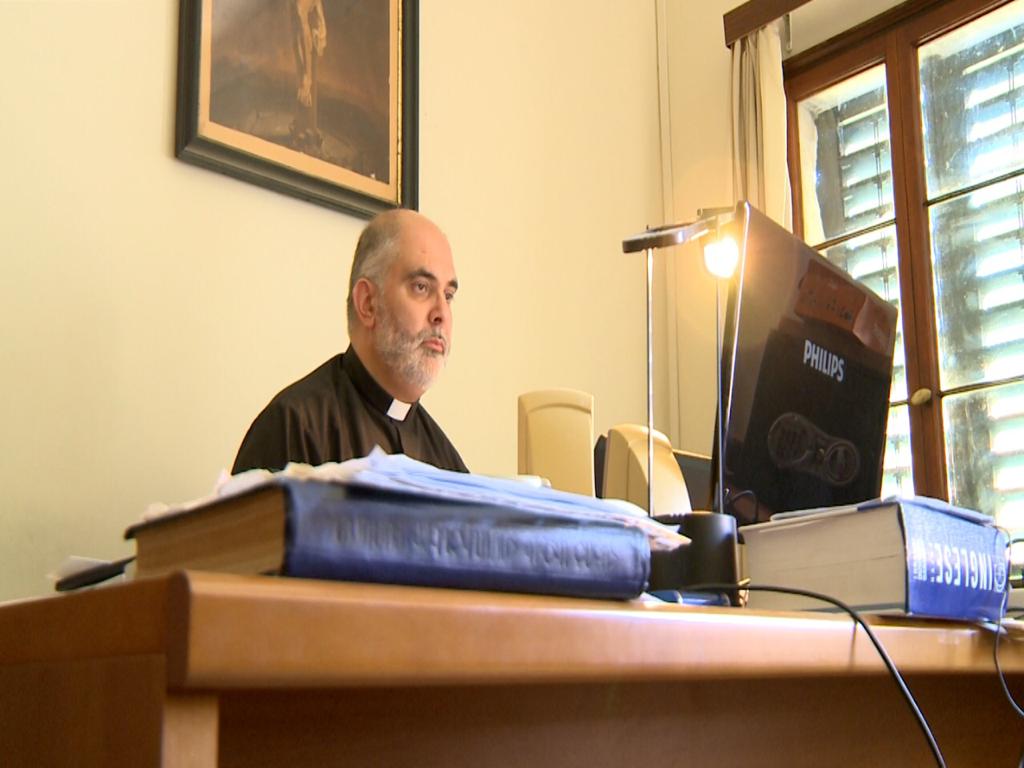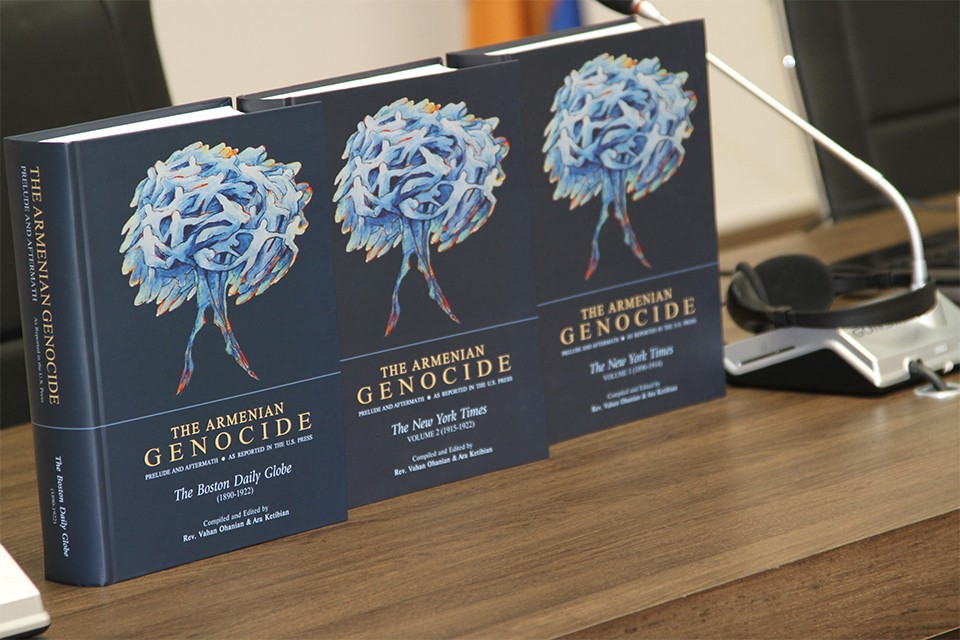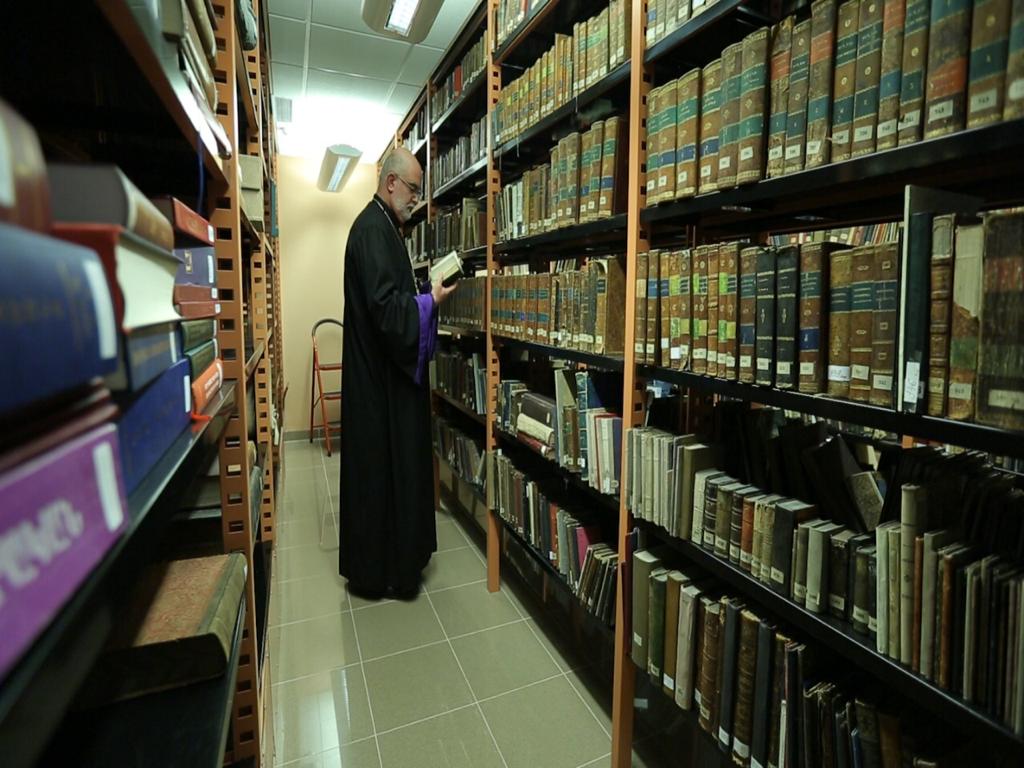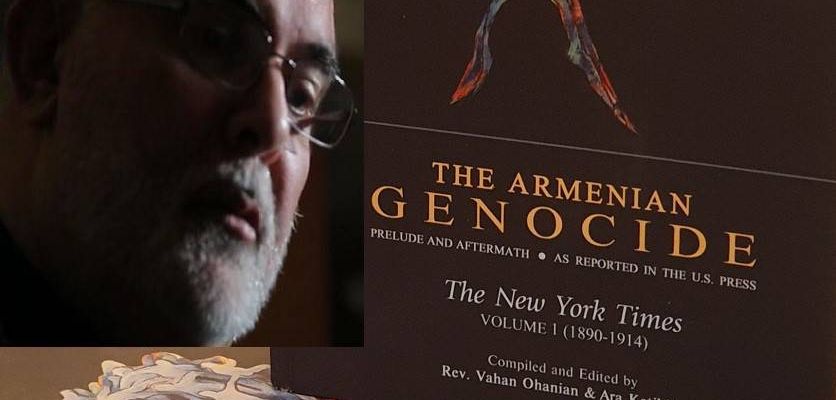'The Armenian Genocide. Prelude and Aftermath': Deeper than any dive into America’s haunting archives
May 03, 2021
It took over hundred years for the United States to acknowledge the Armenian Genocide. But the evidence was always there, covered extensively by the American press, in words and pictures. While there have been several attempts to collect the reports scattered across different newspapers, a recent sequentially arranged and meticulously indexed multi-volume compilation stands out as the weightiest. At an impromptu meeting with h-pem in Venice, Rev. Vahan Ohanian, co-editor of the publication, gives exclusive insights into the gigantic project that goes beyond the traditional scope of presenting the Armenian Question.
It is the least likely place you would expect to find a genocide scholar start each day by accessing a database of thousands of newspaper pages, sifting through articles, making careful selections and precise corrections. Even more so, when the person carrying out this task belongs to a monastic order, with a background in philosophy and theology. Yet, this is just the way things are and have always been on the Armenian Island of St. Lazar in Venice, where the Mekhitarist monks pioneered the Armenian national awakening over three hundred years ago.
“This is not only about missionaries giving testimonies,” says Rev. Vahan Ohanian, as we climb to his office cluttered with books and archive documents. “There is inexhaustible material.”
His computer is on. An archival page from The Washington Post is highlighted with reds and arrows. “There is so much to do. It will make your head spin,” he says. “I dread myself. I pray that God would give me forty-eight hours a day.”
Copies of the first five volumes of “The Armenian Genocide. Prelude and Aftermath. As Reported in the U.S. Press,” planned as a ten-book series, sit on the shelves around the room where they were compiled.
“The computerization of the entire manuscript means that computer-generated content-analysis, word and name searches, listing of headlines, and editing of articles are all now feasible. These features should prove exceedingly beneficial for both researchers and educators,” writes Alan Whitehorn, author of several books on the Armenian Genocide, in the preface to the first volume.
Headlines from The New York Times comprise the first two volumes of the ambitious project that outlines the sequence of events in the Armenian homeland as of Jan. 1890. Together with a compilation of articles from The Christian Science Monitor, The Boston Daily Globe, and The Washington Post, they make up the first seven volumes in the series published so far. Another three volumes with extensive content from The Los Angeles Times and The Chicago Tribune are in preparation.
 “It all started as a hobby,” says Rev. Vahan Ohanian.
“It all started as a hobby,” says Rev. Vahan Ohanian.
The catalyst
The Armenian Question has been the focus of academic attention in the last forty years. There are dozens of books about the Armenian Genocide—the second best-known genocide incident in the world.
I ask Rev. Ohanian what prompted him to put together Armenian topics from the American press archives and make them available as a searchable source.
He smiles and says: “It all started as a hobby.”
At first, Rev. Ohanian was more interested in digging into the French archives. Then, one day, an encounter with a young man in Australia led him to change course and embark on an extensive fact-finding mission to collect articles relevant to Armenians, and to arrange them in chronological order, as recorded in American newspaper archives.
“This young man was doing some really exciting work related to the Armenian Question,” he says. “What struck me the most about him, was his interest in “Hay Endanik” («Հայ Ընտանիք» | Armenian Family), the Armenian periodical published by the Mekhitarists. His family received it regularly, and he used to read the English section. It was due to the Mekhitarists that he had come into contact with his Armenian roots and decided to study Armenian history. He gave me the articles he had downloaded—especially on the Hamidian massacres of the1890s, and this sparked the desire to hunt for more.”
As an editor of “Hay Endanik,” which was published in Venice until the 1990s, Rev. Ohanian is no stranger to the importance of archival material and the lure of hidden knowledge. Even though he refrains from giving the name of the young man, he is quick to show his gratitude: “He also gave me his university password, so that I could access the materials. Otherwise, I wouldn’t have dared to commit to such a terribly costly project,” he confides.
 “The Armenian Genocide. Prelude and Aftermath. As reported in the U.S. Press" is compiled and edited by Rev. Vahan Ohanian & Ara Ketibian (Photo courtesy of VivaCell-MTS)
“The Armenian Genocide. Prelude and Aftermath. As reported in the U.S. Press" is compiled and edited by Rev. Vahan Ohanian & Ara Ketibian (Photo courtesy of VivaCell-MTS)Focused on genocide, but rich in other aspects as well
The hardest part of the compiling process was the beginning. Having developed and outlined the methodology of how to collect pertinent material, Rev. Ohanian credits the help of volunteers from Gyumri with downloading a multitude of articles, which he meticulously researched before selecting the most interesting ones.
“I have mainly tried to cull important pieces related to the Armenian Question. Whatever the subject matter, whatever related to the Armenian Cause are also part of the series, including not only massacres, but also culture and history,” he explains. “You will be surprised to find out how many foreigners have written poems dedicated to the suffering of the Armenian people. But these American papers are also a major source of purely local news concerning Armenian individuals, folklore, and traditions. They can tell us how Armenians settled in America, how they met, how they got married.”
The examples he cites are from an impressively broad range of personal, social, cultural, and economic experiences of Armenians in the United States. They span from wedding photos of Armenian brides and grooms to the photo of an Armenian girl who wins an English language competition. There is the news of an Armenian inventor who builds a new machine, and the story of an Armenian doctor who opens the first pharmacy. There are reports of protests for the rights of Armenian refugee workers, as well as narratives of famous carpet weavers targeted by the mafia.
“Words matter,” says Rev. Ohanian, as we leaf through the pages and come across headlines like “About Armenian Atrocities.” The term “genocide” did not exist then. However, told by their fellow countrymen, such stories have created a sense of urgency among Americans. “Even more so because, prior to 1916, Armenians were portrayed as a culturally vibrant group, with a much richer experience than being a victim,” he explains.
The feel of the times
Indeed, the tomes include a huge amount of information and a wide range of topics that offer the opportunity to study the culture, history, and identity of Armenians in the United States. Rev. Ohanian thinks there are enough stories to make a separate anthology.
“You can spot issues of Armenian newspapers among images of different newspapers published in Boston, as well as reprints of Armenian stamps and coins published in the Armenian-American press,” he says, as he opens different files to illustrate his points.
Some of the newspapers wish their readers a happy new year in the Armenian language—albeit misspelt. Some of them run articles about Armenian writers. There are even stories of Armenian publishing houses and their output. You may come across Armenian texts printed in the Latin alphabet, as well as the first English translations of Armenian poems—The Boston Daily Globe has published pieces by Ghevont Alishan, a piece by Khrimian Hayrik, even a translation of Mikayel Nalbandian’s “Azatutyun” (“Ազատութիւն” | Liberty).
“Imagine that!” he exclaims.
 As an editor of “Hay Endanik,” a periodical which was published in Venice until the 1990s, Rev. Ohanian is no stranger to the importance of archival material and the lure of hidden knowledge.
As an editor of “Hay Endanik,” a periodical which was published in Venice until the 1990s, Rev. Ohanian is no stranger to the importance of archival material and the lure of hidden knowledge.Rev. Ohanian’s almost encyclopedic knowledge of the American press archives is boundless. His interest grows around each new grain of information, like a pearl. A photograph of a hundred-year-old genocide survivor with her eighty-year-old daughter published in two different newspapers in 1915 does not only fascinate him, but also steps up the hunt for new finds. “The photographer’s name guides me to reveal new ones,” he says, not hiding his joy at having discovered precious photographs by the famous Abdullah Brothers, one of whom had studied at the Murat-Rapaelian Armenian College in Venice.
It’s not hard to realize that on a broad level, the series provide hitherto unavailable insights into an entire period of Armenian history.
“You may think we’re deviating from the subject, but we’re not. If you read carefully, you will notice all the connections to the Armenian Question,” he states.
The example he invokes leaves no room for doubt: “Much can be made of the fact that a man from Sasun goes on stage wearing his traditional baggy pants and delivers a speech, which is translated into English for non-Armenian audiences in an American town.”
This is a solid, academic work, that somehow manages to be an entertaining read, too! It helps us identify cause and effect relationships, “reminding us of the pain and joy of being Armenian,” as Rev. Ohanian puts it.
And with all that knowledge we can no longer say the past is forgotten.
“The Armenian Genocide. Prelude and Aftermath. As reported in the U.S. Press,” Compiled and Edited by Rev. Vahan Ohanian & Ara Ketibian, Mekhitarist Publications, (2018-2021)*
- Volume [1]. The New York Times (1890-1914)
- Volume [2]. The New York Times (1915-1922)
- Volume [3]. The Christian Science Monitor (1908-1919)
- Volume [4]. The Christian Science Monitor (1920-1922)
- Volume [5]. The Boston Daily Globe (1890-1922)
- Volume [6]. The Washington Post (1890-1915)
- Volume [7]. The Washington Post (1916-1922)
* The books are not for sale, but are distributed gratuitously to academic institutions and libraries. After the publication of the ten-volume series is completed, it will be available online for all to access.
Join our community and receive regular updates!
Join now!





Attention!